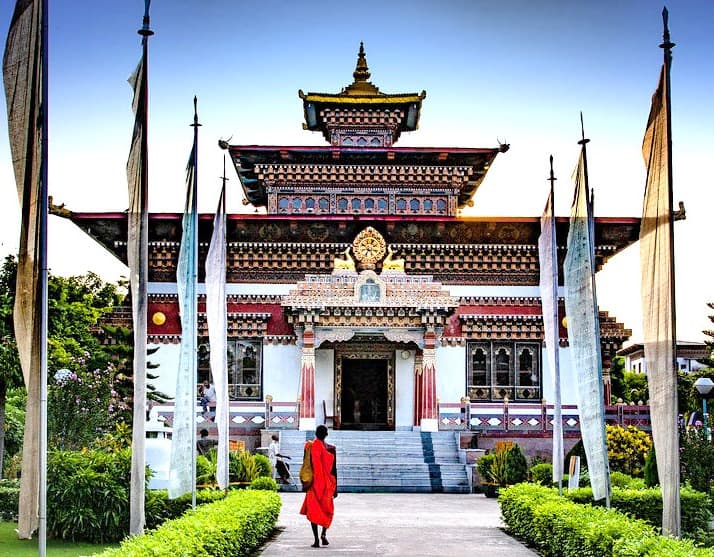- Chimi Lhakhang Bhutan
- The Fertility Temple of Bhutan
- Chimi Lhakhang History
- Phallus Symbols Bhutan
- Lama Drukpa Kunley Temple
- Bhutan Fertility Rituals
- Chimi Lhakhang Hike
- Fertility Pilgrimage in Bhutan
- Best Time to Visit Chimi Lhakhang: The Fertility Temple of Bhutan
- FAQs of Chimi Lhakhang: The Fertility Temple of Bhutan
Chimi Lhakhang Bhutan, widely known as The Fertility Temple of Bhutan, is a revered spiritual site in the heart of Punakha. Renowned for its association with fertility blessings in Bhutan, this iconic temple holds deep historical and cultural significance, rooted in the teachings of Lama Drukpa Kunley, famously known as the "Divine Madman." With a rich Chimi Lhakhang history, the temple is a popular destination for those seeking Bhutan fertility rituals and the unique symbolism of phallus symbols Bhutan, which are believed to ward off evil and promote prosperity. Reached via a short and scenic Chimi Lhakhang hike, this spiritual site in Bhutan is celebrated as one of the most famous temples in Bhutan. It stands among the best temples to visit in Bhutan for its cultural and spiritual importance. As a prominent cultural landmark in Bhutan and one of the significant sacred sites in Punakha, Chimi Lhakhang continues to attract visitors worldwide, particularly couples on fertility pilgrimages in Bhutan.
At Druk Holidays, we take pride in being the best travel company to guide you to Chimi Lhakhang Bhutan, famously known as The Fertility Temple of Bhutan. With our expert knowledge of Chimi Lhakhang history and the unique traditions surrounding fertility blessings in Bhutan, we ensure a meaningful and enriching visit to this renowned spiritual site in Bhutan. As specialists in Bhutanese culture, we provide insights into the significance of phallus symbols in Bhutan and the sacred rituals associated with Bhutan fertility rituals. Whether you are drawn by the scenic Chimi Lhakhang hike, intrigued by the teachings of Lama Drukpa Kunley, or simply exploring famous temples in Bhutan, we make your journey seamless and unforgettable. Trust Druk Holidays to make your visit to this cultural landmark in Bhutan and one of the most cherished sacred sites in Punakha a truly memorable experience.
Chimi Lhakhang Bhutan
Chimi Lhakhang Bhutan, also known as The Fertility Temple of Bhutan, is a vibrant and sacred destination nestled in the heart of Punakha Valley. Renowned for its connection to Lama Drukpa Kunley, this temple holds a special place in Bhutanese culture, attracting visitors from around the world, particularly those seeking blessings for fertility and family. The rich history, unique traditions, and serene location make it one of Bhutan's most beloved spiritual sites.
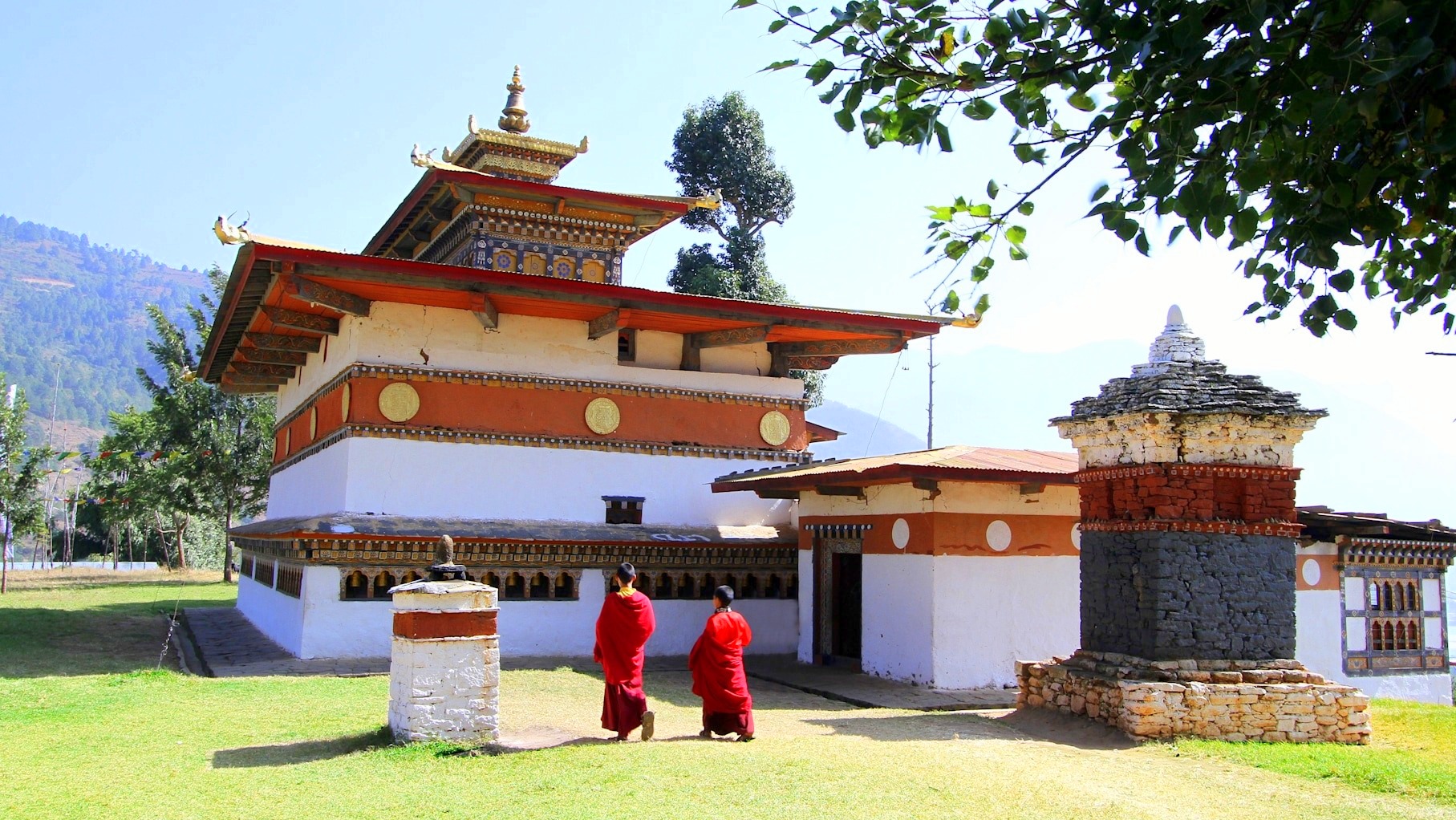
- Sacred Wooden Phallus: The temple features a wooden phallus that plays a central role in the fertility rituals in Bhutan, believed to bring blessings and protection to visitors.
- Vibrant Wall Paintings: Intricate murals depict the life and teachings of Lama Drukpa Kunley, showcasing his unconventional methods and profound wisdom.
- Chimi Lhakhang’s Peaceful Surroundings: Set amidst peaceful rice fields and lush greenery, the temple offers a tranquil environment for reflection and spiritual growth.
- Unique Fertility Blessings: Couples and individuals receive special prayers from the monks, believed to enhance fertility, happiness, and prosperity.
- Iconic Bhutanese Architecture: The temple is a stunning example of traditional Bhutanese architecture, with its colorful prayer flags, intricate woodwork, and ornate designs.
- Local Legends and Myths: The temple is steeped in local folklore, including stories of miraculous events attributed to Lama Drukpa Kunley’s spiritual powers.
- Chimi Lhakhang Festivals: Visitors can experience local festivals that celebrate Bhutanese culture, spirituality, and the teachings of Lama Drukpa Kunley.
Chimi Lhakhang Bhutan is not just a temple; it’s a destination where visitors can experience the deep spirituality and rich cultural heritage of Bhutan. Whether you're seeking fertility blessings, exploring the historical teachings of Lama Drukpa Kunley, or simply enjoying the serene beauty of the Punakha Valley, Chimi Lhakhang promises an unforgettable journey into the heart of Bhutanese spirituality and tradition.
The Fertility Temple of Bhutan
The Fertility Temple of Bhutan, more commonly known as Chimi Lhakhang, is a cherished and spiritual landmark in the Punakha Valley. This sacred temple draws people from all over the world, particularly those seeking blessings related to fertility and family. Steeped in the rich history of Lama Drukpa Kunley, the temple offers not only a spiritual sanctuary but also a profound cultural experience. Here are some of the highlights that make The Fertility Temple of Bhutan a must-visit destination for travelers and pilgrims alike.
- Phallic Artifacts and Symbols: One of the most distinctive features of the temple is the display of phallic symbols, which are associated with fertility and protection. These symbols are an integral part of Bhutanese traditions, brought to life through paintings, sculptures, and charms.
- Monastic Blessings for Childbirth: Visitors to the temple can receive blessings from the monks for fertility, and many couples come to the temple to pray for children or a happy family life.
- Drukpa Kunley’s Relics: The temple houses relics of Lama Drukpa Kunley, whose teachings on joy and liberation have deeply influenced Bhutanese spirituality. His legacy is reflected in the lighthearted yet profound atmosphere of the temple.
- Traditional Bhutanese Festivals: During certain times of the year, the temple is the focal point of traditional Bhutanese celebrations, where you can witness the vibrant colors and ceremonial dances of the local community.
- Stunning Views of the Punakha Valley: As you walk through the temple’s grounds, you are treated to breathtaking panoramic views of the lush Punakha Valley, surrounded by rice fields and picturesque landscapes.
- Rich Folk Stories and Mythology: The temple is surrounded by captivating folk tales and myths that explain the symbolic meanings of the temple’s teachings, with many stories linked to Lama Drukpa Kunley's adventures.
- Local Community Involvement: The temple serves as a gathering place for the local community, where Bhutanese people come together for spiritual reflection and to receive blessings, creating a unique cultural exchange between visitors and locals.
- Spiritual Journey for Travelers: For many, a visit to The Fertility Temple of Bhutan is a spiritual pilgrimage, filled with moments of introspection, prayer, and connection with Bhutanese spiritual practices.
The Fertility Temple of Bhutan offers an enriching experience that combines cultural heritage, spiritual reflection, and a deep sense of community. Whether you are seeking fertility blessings, exploring Lama Drukpa Kunley’s teachings, or simply appreciating Bhutan’s rich traditions, this temple provides a unique opportunity to witness Bhutanese spirituality and culture at its finest.
Chimi Lhakhang History
Chimi Lhakhang, located in the Punakha Valley, is not only a renowned fertility temple but also a historical site filled with rich cultural and spiritual significance. Founded in the 15th century by Lama Drukpa Kunley, also known as the Divine Madman, this temple holds a unique place in Bhutanese history. It was built to honor Lama Drukpa Kunley, whose unconventional methods and teachings have left a lasting impact on Bhutanese society. Over the centuries, Chimi Lhakhang has become a symbol of fertility, love, and protection, attracting countless pilgrims and visitors. Here are some of the historical highlights that define Chimi Lhakhang.
- Foundation by Lama Drukpa Kunley: The temple was built in 1499 by Lama Drukpa Kunley, a charismatic monk who is said to have performed miracles and spread the teachings of love, fertility, and liberation throughout Bhutan.
- The Symbol of Fertility: Lama Drukpa Kunley’s association with fertility is central to the temple’s history. He blessed the land and its people, and the temple has since been a place for couples seeking blessings for children.
- Miraculous Stories of Lama Drukpa Kunley: Historical accounts recount how the Divine Madman tamed the infamous demoness of the valley, and the temple marks the spot of this legendary event, showcasing his spiritual power and wisdom.
- Role in Bhutanese Religion: Over the years, Chimi Lhakhang has become a symbol of Bhutanese Buddhism, with its teachings influencing both the religious and cultural fabric of the country.
- The Legend of the Sacred Phallus: The use of the phallus symbol, which originated with Lama Drukpa Kunley, became a hallmark of the temple, believed to ward off evil spirits and bring fertility and prosperity.
- A Pilgrimage Site for Centuries: Since its founding, Chimi Lhakhang has served as a pilgrimage site for Bhutanese people and visitors alike, drawing those seeking blessings for fertility, love, and spiritual well-being.
- Protection from Evil: Historically, the temple was also seen as a place of protection, with Lama Drukpa Kunley using his spiritual strength to shield the community from harmful forces, reinforcing the temple’s place as a sanctuary for good health and happiness.
- A Legacy of Bhutanese Tradition: The temple remains a living example of Bhutan’s traditional culture, where its historical significance continues to influence contemporary Bhutanese life through rituals, stories, and customs passed down through generations.
Chimi Lhakhang’s history is a testament to the enduring power of Lama Drukpa Kunley’s teachings and the cultural significance of fertility rituals in Bhutan. From its foundation in the 15th century to its continued importance today, the temple represents not only a spiritual site but also a key piece of Bhutan’s religious and cultural heritage. Whether you are interested in its historical context, the myths surrounding Lama Drukpa Kunley, or the fertility blessings it offers, Chimi Lhakhang remains a timeless symbol of Bhutan’s unique spiritual traditions.
Phallus Symbols Bhutan
The phallus symbol holds deep cultural and spiritual significance. Widely recognized as a symbol of fertility, prosperity, and protection, these symbols can be found throughout the country, especially in sacred sites like Chimi Lhakhang. Rooted in the teachings of Lama Drukpa Kunley, the use of the phallus as a symbol has been embraced for centuries to ward off evil spirits, promote good health, and bless families with children. Though often surprising to visitors, the phallus symbols are an integral part of Bhutanese tradition, carrying profound meaning in the Bhutanese belief system.
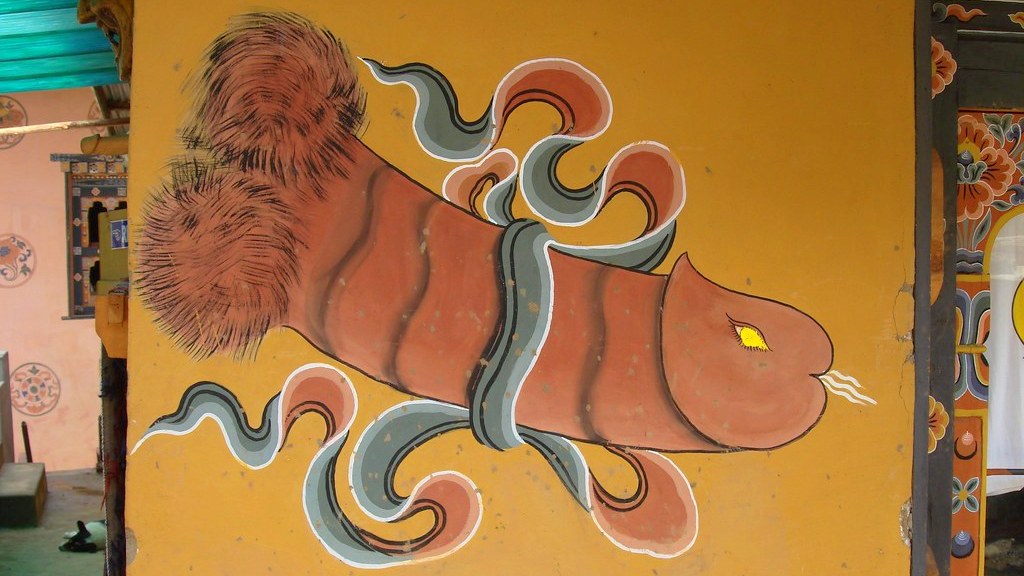
- Symbol of Fertility: The phallus is considered a powerful symbol of fertility and abundance in Bhutan. It is believed to bring blessings for childbearing, particularly in temples like Chimi Lhakhang, where it is prominently featured.
- Cultural Protection: The symbol is also thought to protect individuals and homes from harmful spirits. Painted phalluses on houses and buildings are believed to safeguard the occupants and maintain a positive energy flow.
- Association with Lama Drukpa Kunley: The presence of phallus symbols in Bhutan can be traced back to Lama Drukpa Kunley, who used the symbol in his teachings to represent both spiritual enlightenment and a joyful approach to life.
- Fertility Rituals: The phallus symbols are closely tied to fertility rituals and blessings, especially in regions like Punakha Valley, where couples visit temples like Chimi Lhakhang seeking blessings for children.
- Decorative Art: The phallus appears in various forms of Bhutanese art, including paintings, carvings, and woodwork. These artistic representations often carry spiritual and protective messages.
- Tradition in Bhutanese Homes: The symbol is commonly painted above doorways and on walls of Bhutanese homes, as a way to invite prosperity and keep negative energy at bay.
- Phallus Festivals: During traditional Bhutanese festivals, such as those at Chimi Lhakhang, the phallus symbol plays a central role in the celebrations, where people seek both fertility and spiritual protection.
- Incorporation in Bhutanese Folklore: Bhutanese legends and folk stories often mention phallus symbols, with many tales attributing miraculous powers to the symbol, further embedding its significance in the country’s spiritual practices.
The phallus symbols in Bhutan are not merely decorative but are a powerful cultural element that reflects the country’s deep spiritual beliefs. Linked to fertility, prosperity, and protection, these symbols can be found throughout Bhutan, from sacred temples like Chimi Lhakhang to homes and festivals. Embraced as part of Bhutanese tradition, the phallus symbol continues to play a vital role in the everyday life of the Bhutanese people, offering both blessings and spiritual protection for generations to come.
Lama Drukpa Kunley Temple
The Lama Drukpa Kunley Temple, often associated with Chimi Lhakhang, is one of the most revered temples in Bhutan. It is dedicated to Lama Drukpa Kunley, a 15th-century saint known for his unconventional teachings, eccentric behavior, and profound spiritual insights. Nicknamed the Divine Madman, Lama Drukpa Kunley is celebrated for his unique methods of spreading Buddhism, using humor, unorthodox rituals, and symbolic teachings to challenge the status quo. The Lama Drukpa Kunley Temple stands as a testament to his legacy, attracting pilgrims and travelers who seek a deeper understanding of his teachings on love, liberation, and joy.
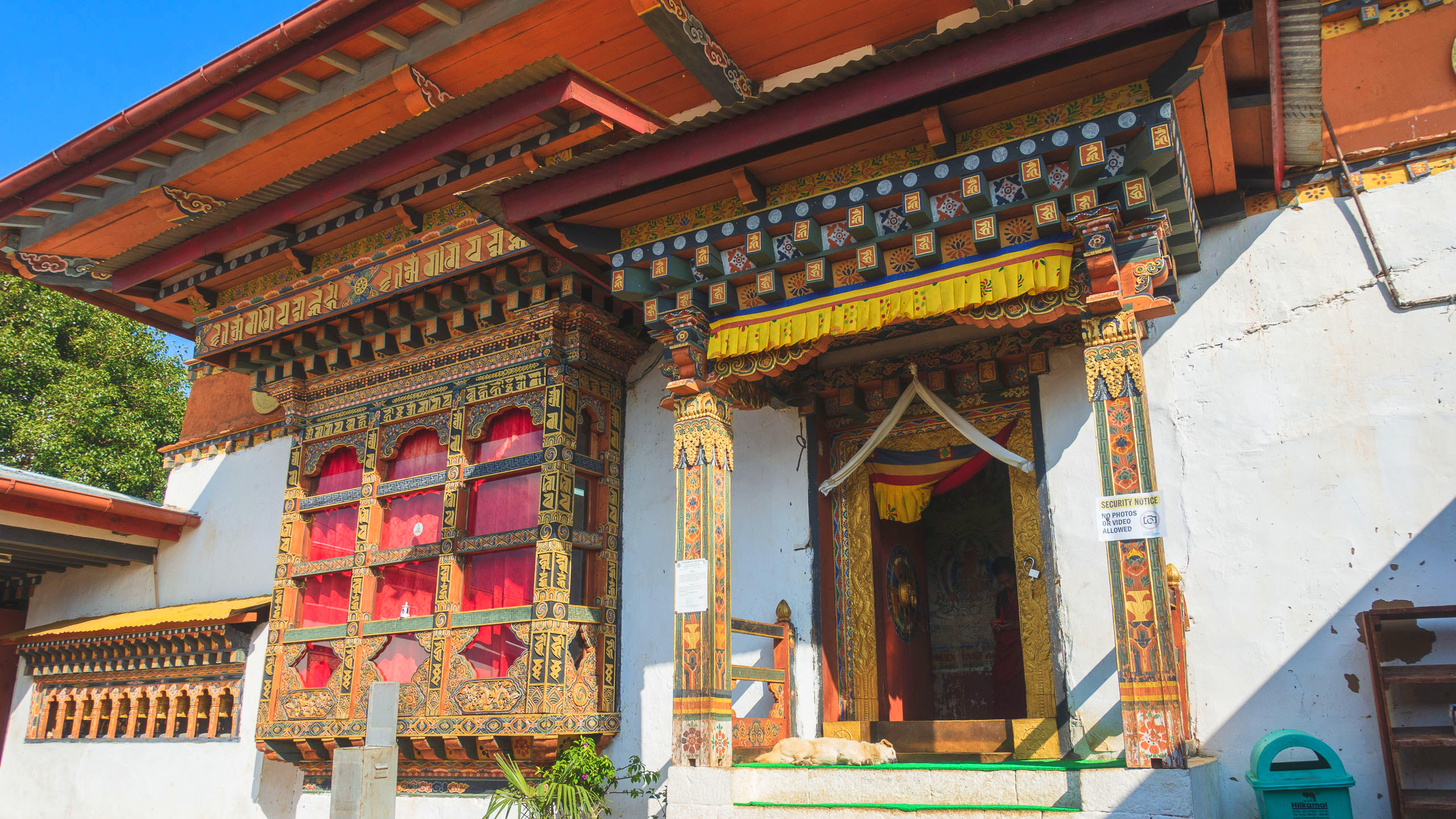
- Legacy of the Divine Madman: The temple is built in honor of Lama Drukpa Kunley, who is believed to have performed many miracles in the region, influencing both the spiritual and cultural landscape of Bhutan.
- Location and Scenic Beauty: Situated in the Punakha Valley, the temple offers stunning views of the surrounding mountains and lush landscapes, making it not just a spiritual site but also a place of tranquility and natural beauty.
- Iconic Phallic Symbolism: As with Chimi Lhakhang, the Lama Drukpa Kunley Temple is adorned with phallic symbols, which represent fertility, protection, and the breaking of societal taboos. These symbols play a significant role in Bhutanese beliefs.
- Spiritual Practices and Teachings: Visitors to the temple often receive blessings and teachings associated with Lama Drukpa Kunley, who promoted a joyful, liberated approach to life, encouraging his followers to embrace both the sacred and the profane.
- Pillars of Wisdom: The temple features inscriptions of the Lama’s wisdom, offering insights into his life’s work and philosophy, which continue to inspire and challenge visitors today.
- Historical Significance: The temple is not only a religious site but also an important historical landmark in Bhutan, symbolizing the spread of Drukpa Kagyu Buddhism throughout the country.
- Cultural Importance: Lama Drukpa Kunley Temple is a center of Bhutanese culture, where local festivals, religious ceremonies, and cultural gatherings are held, drawing the community together to celebrate their shared heritage.
- A Sacred Pilgrimage Site: The temple is a key destination for pilgrims, especially those seeking fertility blessings or spiritual guidance in their personal lives. It continues to draw visitors from around the world who wish to connect with the teachings of Lama Drukpa Kunley.
The Lama Drukpa Kunley Temple is a revered site that blends spirituality, history, and culture in a profound way. Dedicated to the life and teachings of the Divine Madman, this temple not only serves as a place of fertility rituals and spiritual blessings but also offers a deeper understanding of Bhutanese Buddhism. Whether you are drawn to its phallus symbols, its scenic surroundings, or its historical significance, a visit to Lama Drukpa Kunley Temple is a unique experience that offers both reflection and enlightenment.
Bhutan Fertility Rituals
Fertility rituals are deeply woven into the fabric of the country’s spiritual and cultural life. These rituals, performed at sacred temples such as Chimi Lhakhang, have been practiced for centuries, offering blessings to couples seeking children and families praying for prosperity. Rooted in the teachings of Lama Drukpa Kunley, these ceremonies invoke spiritual powers believed to help overcome barriers to conception and bring blessings for happiness, health, and abundant life. While fertility rituals vary from region to region, they are universally regarded as an important aspect of Bhutanese life, symbolizing the connection between spiritual belief and daily existence.
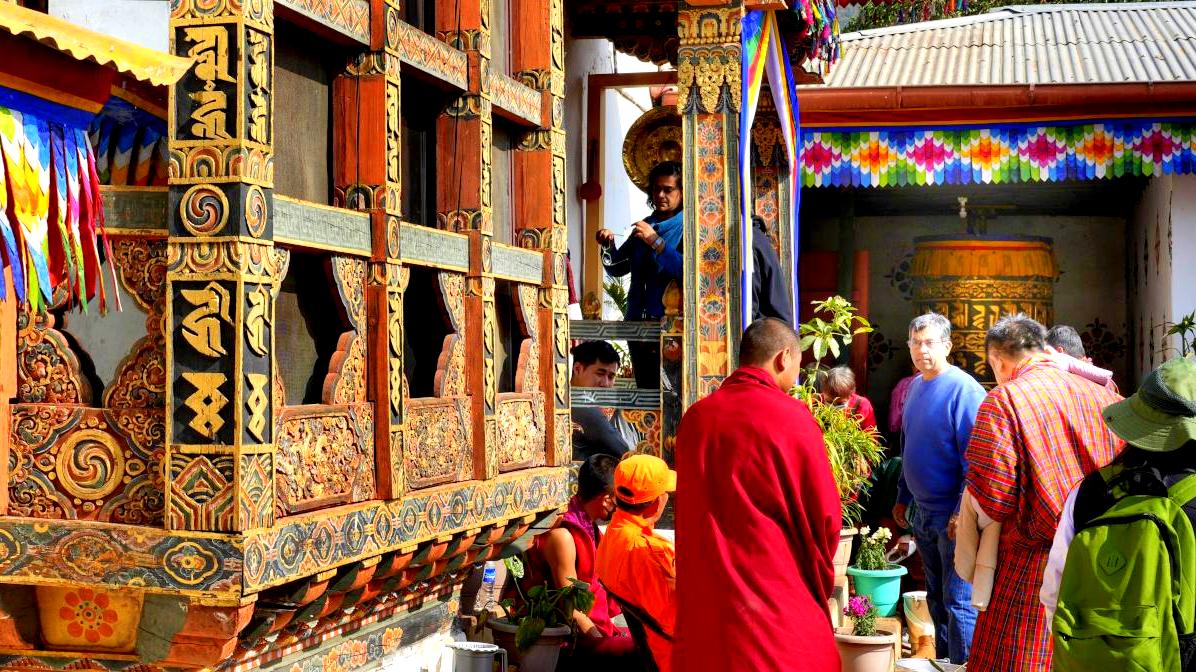
- Sacred Temples as Ritual Centers: Temples like Chimi Lhakhang are central to Bhutanese fertility rituals, where couples visit to seek blessings and protection for their future children. These sites are believed to have powerful spiritual energy that can aid in conception.
- Blessings by Monks: Monks often perform special prayers and blessings for couples, invoking divine protection and fertility, ensuring that the couple’s home is filled with happiness and the promise of new life.
- Use of the Phallus Symbol: The phallus symbol, associated with Lama Drukpa Kunley, plays a significant role in fertility rituals. The symbol is thought to ward off evil spirits and promote fertility, bringing prosperity to families.
- Water Blessings: During fertility rituals, sacred water is often blessed by monks and sprinkled on couples, believed to carry divine energy that encourages fertility and good health.
- The Offering of Fruits and Flowers: Fruits and flowers are commonly offered during fertility prayers, symbolizing abundance, growth, and the cycle of life, while also asking for divine intervention for healthy offspring.
- Sacred Pilgrimages: Many couples embark on a fertility pilgrimage, traveling to famous fertility temples across Bhutan, including Lama Drukpa Kunley Temple, in hopes of receiving blessings and spiritual guidance.
- Community Celebrations: In some communities, fertility rituals are integrated into local festivals where the entire village participates, creating a sense of collective hope and spiritual support for families trying to conceive.
- Spiritual Healing and Guidance: In addition to traditional prayers, many Bhutanese fertility rituals involve spiritual healers who offer personalized guidance, using divine tools like mantras, prayers, and protective amulets to bring balance and fertility to families.
Bhutan’s fertility rituals are an integral part of the country’s spiritual practices, symbolizing hope, prosperity, and the deep connection between the physical and spiritual realms. Whether in sacred temples or community celebrations, these rituals are designed to bless couples with children, protect families, and ensure the growth and prosperity of future generations. With the influence of Lama Drukpa Kunley’s teachings, fertility rituals in Bhutan remain powerful and enduring, continuing to shape the spiritual lives of the Bhutanese people.
Chimi Lhakhang Hike
The Chimi Lhakhang Hike is a short but rewarding trek that leads visitors through the picturesque Punakha Valley to one of Bhutan’s most significant spiritual sites, Chimi Lhakhang, also known as the Fertility Temple of Bhutan. This easy-to-moderate hike offers breathtaking views of the surrounding valley, rich cultural experiences, and an opportunity to connect with Bhutanese spirituality. The Chimi Lhakhang Hike is particularly popular among visitors seeking blessings for fertility, and its serene atmosphere makes it a must-do journey for anyone traveling to Bhutan.
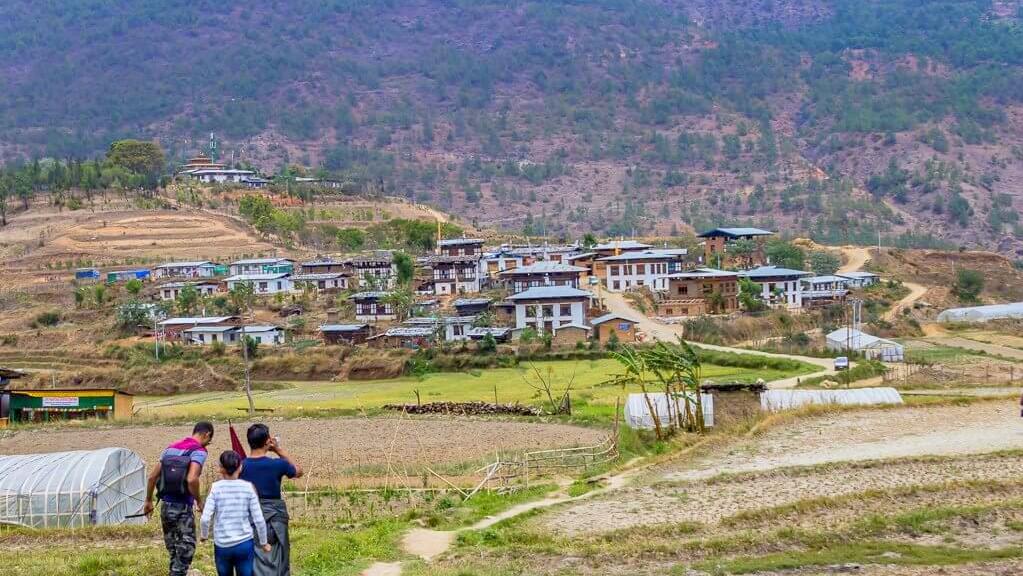
- Scenic Views of Punakha Valley: The hike provides incredible views of the lush Punakha Valley, including the terraced rice fields, flowing rivers, and the majestic Himalayas in the distance.
- Walk through Charming Villages: Along the way, hikers pass through traditional Bhutanese villages, where they can interact with the locals and experience authentic rural life.
- Easy Accessibility: The Chimi Lhakhang Hike is suitable for most fitness levels, with a gentle ascent through beautiful landscapes, making it an ideal option for families and first-time trekkers.
- The Fertility Temple Experience: Reaching the temple itself is the highlight of the hike. Chimi Lhakhang, dedicated to Lama Drukpa Kunley, is an iconic site known for its powerful fertility blessings and symbolic phallus imagery.
- Spiritual Atmosphere: The hike offers a chance to absorb the serene, spiritual atmosphere of the Chimi Lhakhang Temple, where monks offer blessings to visitors for fertility and good health.
- Sacred Bamboo Forest: On the way to the temple, hikers walk through a bamboo forest that adds a mystical touch to the trek, making the journey feel even more sacred.
- Cultural Immersion: The trail is rich with Bhutanese culture. Visitors will see traditional Bhutanese architecture, prayer flags fluttering in the wind, and hear the sounds of local prayers.
- End Point at Chimi Lhakhang: Upon arrival at Chimi Lhakhang, visitors can explore the temple’s courtyard, admire the murals and carvings, and participate in a fertility blessing for personal or family growth.
The Chimi Lhakhang Hike offers a unique opportunity to explore the natural beauty and spiritual heritage of Bhutan. From its stunning vistas of the Punakha Valley to the sacred surroundings of Chimi Lhakhang, this hike is an experience that combines physical activity with cultural and spiritual enrichment. Whether seeking blessings or simply looking to enjoy the serenity of the Bhutanese countryside, the Chimi Lhakhang Hike is an unforgettable journey into the heart of Bhutan’s heritage.
Fertility Pilgrimage in Bhutan
The Fertility Pilgrimage in Bhutan is a deeply spiritual journey that takes visitors to some of the most revered temples and sacred sites across the country, where they seek blessings for fertility, prosperity, and family well-being. Rooted in the teachings of Lama Drukpa Kunley, also known as the Divine Madman, these pilgrimage sites are places where Bhutanese people—and travelers alike—pray for divine intervention in their personal lives. The pilgrimage is not just about seeking blessings for children; it is also a quest for spiritual enlightenment, inner peace, and cultural connection.
- Chimi Lhakhang (The Fertility Temple): As the centerpiece of the pilgrimage, Chimi Lhakhang in Punakha is a powerful site where couples receive fertility blessings. The temple’s connection with the phallus symbol offers protection and fertility, making it a must-visit on the pilgrimage.
- Lama Drukpa Kunley’s Influence: The pilgrimage follows the spiritual path of Lama Drukpa Kunley, whose unconventional and joyful approach to Buddhism has become a central part of the fertility rituals practiced in Bhutan.
- Sacred Water Rituals: At several points during the pilgrimage, visitors partake in sacred water blessings, which are believed to cleanse the spirit and promote fertility and health.
- Sacred Temples and Monasteries: Pilgrims visit a variety of temples and monasteries, including those dedicated to fertility deities, such as Punakha Dzong, Wangdue Phodrang, and Kyichu Lhakhang, all significant spiritual landmarks tied to fertility.
- The Blessing of Phallus Symbols: Phallic symbols, prominently featured at pilgrimage sites like Chimi Lhakhang, are believed to ward off evil and bring blessings of fertility, prosperity, and happiness to those who seek it.
- Offerings at Temples: During the pilgrimage, visitors make offerings of fruits, flowers, and symbolic items at each temple, asking for blessings of fertility and health for themselves and their families.
- Community Celebrations: The pilgrimage often coincides with local festivals, where entire communities come together to celebrate fertility, life, and the arrival of new beginnings. These events offer a glimpse into Bhutanese culture and traditions.
- Personalized Blessings from Monks: Visitors receive personalized blessings from monks during the pilgrimage, where prayers are offered for individuals and families seeking fertility or general spiritual well-being.
The Fertility Pilgrimage in Bhutan is a profound journey that combines faith, culture, and tradition in the most serene and spiritually enriching way. Whether seeking fertility blessings or simply wishing to experience Bhutan's unique spiritual heritage, this pilgrimage offers a transformative experience that leaves lasting memories. From the symbolic phallus symbols to the powerful blessings at sacred temples, the Fertility Pilgrimage in Bhutan is a remarkable exploration of the country’s rich spiritual traditions and the powerful role of fertility rituals in its culture.
Best Time to Visit Chimi Lhakhang: The Fertility Temple of Bhutan
The Chimi Lhakhang temple, located in the beautiful Punakha Valley, is a popular destination for both spiritual seekers and nature lovers. To make the most of your visit, it’s important to understand the seasonal variations in Bhutan. Each season offers a unique experience, from clear skies to lush greenery, making it possible to visit year-round. Below is a guide to the best times to visit Chimi Lhakhang throughout the year.
- Spring (March to May): Spring is one of the most delightful seasons to visit Chimi Lhakhang, as the Punakha Valley comes alive with vibrant flowers and blossoming trees. The weather is pleasant, with mild temperatures ranging from 12°C to 22°C (54°F to 72°F), making it ideal for a comfortable hike to the temple. The surrounding landscapes are lush and green, and the valley is at its most picturesque. Spring is also a popular time for festivals, so visitors may experience special cultural ceremonies and blessings related to fertility rituals, enhancing the spiritual atmosphere of Chimi Lhakhang.
- Summer (June to August): Summer in Bhutan is characterized by warmer temperatures and frequent rainfall, particularly in the monsoon season (from June to August). While the rain may create some challenges for hiking, it also results in the lushest landscapes. The Punakha Valley is especially green and thriving, with rich vegetation and vibrant rice paddies. If you don’t mind getting a bit wet, summer offers a quieter time to visit the Fertility Temple without large crowds. Visitors can enjoy a more tranquil experience, surrounded by the serene beauty of nature. However, it’s important to be prepared for occasional downpours and slippery trails.
- Autumn (September to November): Autumn is arguably the best season to visit Chimi Lhakhang. The weather is clear and crisp, with daytime temperatures ranging from 15°C to 23°C (59°F to 73°F), and the Punakha Valley is bathed in golden hues. The monsoon rains have subsided, leaving the landscape fresh and vibrant. The views of the valley and the Himalayan range are stunning, offering the perfect backdrop for exploring the fertility temple. This is also the time when many important Buddhist festivals are celebrated in Bhutan, including the Punakha Drubchen festival, where pilgrims and visitors alike gather for blessings at Chimi Lhakhang.
- Winter (December to February): Winter is the least crowded time to visit Chimi Lhakhang, and it offers a serene and peaceful experience. Temperatures drop to around 5°C to 15°C (41°F to 59°F), so visitors should be prepared for colder weather, especially during early mornings and late evenings. The Punakha Valley tends to be quieter, making it a great time to enjoy solitude and reflection. While the landscape may be less lush compared to the other seasons, winter offers clear skies and crisp air, providing beautiful panoramic views of the surrounding mountains. It’s a peaceful time for those seeking a more contemplative visit, away from the bustling tourist crowds.
Each season in Bhutan offers a unique experience when visiting Chimi Lhakhang, the Fertility Temple of Bhutan. Whether you prefer the vibrant blossoms of spring, the lush greenery of summer, the clear skies and festivals of autumn, or the peaceful solitude of winter, Chimi Lhakhang is a spiritual and cultural landmark worth visiting year-round. The best time to visit depends on your preference for weather, crowds, and activities, making it a flexible destination for any type of traveler.
Chimi Lhakhang, the Fertility Temple of Bhutan, is a remarkable spiritual and cultural landmark located in the serene Punakha Valley. Whether you're visiting to seek fertility blessings or simply to experience the rich history and traditions of Bhutan, the temple offers a peaceful and transformative experience. Surrounded by stunning landscapes and steeped in the teachings of Lama Drukpa Kunley, Chimi Lhakhang is not only a site of spiritual significance but also a symbol of Bhutan’s unique cultural identity. From its striking phallus symbols to its profound fertility rituals, the temple continues to inspire and bless visitors from all walks of life. Regardless of the season, a visit to Chimi Lhakhang is a journey into Bhutan's heart, offering insight, serenity, and a deeper connection to the country’s spiritual heritage.
FAQs of Chimi Lhakhang: The Fertility Temple of Bhutan
Q: What is Chimi Lhakhang?
A: Chimi Lhakhang is a renowned temple in Punakha, Bhutan, dedicated to Lama Drukpa Kunley, also known as the Divine Madman. It is widely regarded as the Fertility Temple of Bhutan, where people come to seek blessings for fertility, family well-being, and prosperity.
Q: Why is Chimi Lhakhang known as the Fertility Temple?
A: The temple is associated with the teachings and blessings of Lama Drukpa Kunley, who is believed to have used the symbol of the phallus to ward off evil and bring blessings of fertility. The temple features phallus symbols, which are considered symbols of protection and fertility in Bhutanese culture.
Q: How can I get to Chimi Lhakhang?
A: Chimi Lhakhang is located in the Punakha Valley, about a 30-minute drive from Punakha Dzong. Visitors typically hike for around 20-30 minutes from the base to reach the temple, enjoying beautiful views of the valley along the way.
Q: Is there a best time to visit Chimi Lhakhang?
A: The best time to visit Chimi Lhakhang is during autumn (September to November) when the weather is clear, and the landscape is at its most beautiful. However, spring and winter also offer unique experiences. Summer can be rainy, but it offers lush, green scenery.
Q: What rituals take place at Chimi Lhakhang?
A: Visitors to Chimi Lhakhang often participate in fertility rituals, where they are blessed by monks and can make offerings to receive blessings for fertility and family happiness. The temple is also a site for other spiritual practices, such as prayers for health and prosperity.
Q: Can anyone visit Chimi Lhakhang, or is it only for fertility blessings?
A: While Chimi Lhakhang is known for fertility blessings, it is open to all visitors interested in experiencing Bhutan’s unique spiritual culture, history, and architecture. Many visitors come for the cultural and historical significance, not only for fertility-related blessings.
Q: What are the phallus symbols at Chimi Lhakhang?
A: The phallus symbols found around the temple are an important part of Bhutanese culture, especially linked to Lama Drukpa Kunley’s teachings. These symbols represent fertility, protection from evil spirits, and prosperity, and are often seen on buildings, household items, and even on the walls of the temple.
Q: Is there an entrance fee to visit Chimi Lhakhang?
A: There is generally no entrance fee to visit Chimi Lhakhang, but visitors are encouraged to make offerings as a sign of respect and support for the temple’s upkeep. Donations are often welcomed by the monks in charge.
Q: What should I wear when visiting Chimi Lhakhang?
A: It is recommended to wear respectful and modest clothing when visiting Chimi Lhakhang, as it is a sacred site. Comfortable shoes for the short hike up to the temple are also a good idea, especially during the warmer months.
Q: Are there any other nearby attractions to visit?
A: Yes, there are several other attractions near Chimi Lhakhang, including the majestic Punakha Dzong, the Wangdue Phodrang area, and the Khamsum Yulley Namgyal Chorten, all offering unique cultural and historical experiences.


